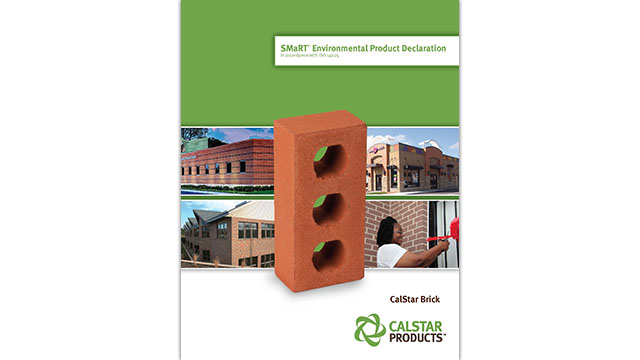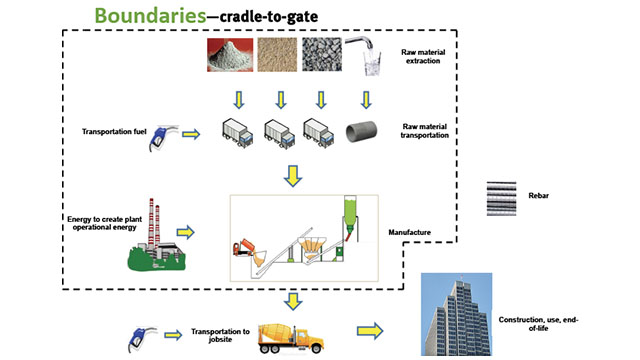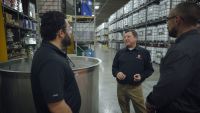Product benchmarking for greener buildings
Green building
Selecting masonry products requires consideration of a number of attributes – performance, aesthetics and cost, to name just a few. If you’re working on a green building, the list grows. Products for sustainable projects require an additional level of scrutiny to determine environmental impacts, including operational and embodied energy, carbon footprint, and impact on human and ecosystem health.
Historically, the evaluation of environmental criteria relied upon manufacturer claims, with some stakeholders researching specific aspects of a product’s composition and manufacture. But the emergence of independently conducted life cycle assessments (LCAs) and third-party-verified environmental product declarations (EPDs) provides specifiers with helpful tools for accurately comparing similar products’ environmental attributes.
What is product benchmarking?
Product benchmarking provides standardized methods for verifying manufacturers’ environmental claims and allows for accurate side-by-side comparisons of the environmental impacts of two or more products. This type of evaluation is key to the green building process, because it provides a truly transparent method of making consistent product comparisons. Accurate assessments of products’ environmental impacts enable reduction of the overall building’s environmental impact.As with many fields, product transparency has its own specialized lingo.
ISO
The International Organization for Standardization – an independent body that creates the rules for how product category rules should be written and how Life Cycle Assessments should be conducted.LCA
A life cycle assessment (LCA) is an analysis of every component of a product’s manufacture and use. The life cycle includes raw material extraction and transportation to the manufacturing site (extraction phase), the manufacturing phase, transportation to jobsite and construction (construction phase), use phase, and end-of-life phase.An ISO-compliant life cycle assessment is conducted by an independent third party, ensuring unbiased results and confidence by end users.
PCR
A product category rule (PCR) is the standardized method for conducting and reporting a life cycle assessment. The PCR ensures that all products in a certain category (e.g., ready mix concrete or roofing products) are measured the same way in each life cycle phase and that environmental impacts are quantified in the same way. The PCR defines the boundaries for measurement (such as cradle-to-gate or cradle-to-grave), as well as the functional unit measured (e.g., one cubic yard of concrete or 100 square feet of a roofing material).PCRs are developed using a consensus-based, collaborative, transparent process by industry experts and stakeholders. They are then verified by an expert review panel. The entire process must follow certain ISO guidelines.
At present, the number of PCRs is not large. This is starting to change, with more PCRs developed each year.

EPD
An environmental product declaration (EPD) is a document created by a manufacturer to show the results of a life cycle assessment of a product (see Figure 1). It is verified by an expert and approved by a program operator, such as UL Environment (ULE) or the Institute for Market Transformation to Sustainability (MTS).EPDs enable stakeholders to make accurate, direct comparisons of environmental attributes – such as carbon footprint and embodied energy – of similar products.
These three acronyms work together: Product category rules are developed; a life cycle assessment is performed according to the PCR; and an environmental product declaration publishes the results of the LCA.
Impact category
Impact categories describe the effect of a product on specific areas of concern. Impact categories include, but are not limited to, global warming potential (aka, carbon footprint), fossil fuel depletion (aka, embodied energy), smog and ozone depletion. PCRs define which impact categories must be reported in each EPD.Of course, EPDs can always report more impact categories than required by the PCR. When evaluating product choices, specifiers can consider those impact categories that are of greatest importance for each project. For instance, while carbon footprint is likely always a concern, in arid regions, impact on water resources might also be an important consideration.

Boundaries
Boundaries are an important element in life cycle assessment and associated EPDs (see Figure 2). Simply put, where does the product system start and stop? Does the LCA consider the electricity used to power the plant and also the energy required to create that electricity? Does the EPD include cradle-to-grave impacts (all life cycle phases) or only cradle-to-gate impacts (raw material extraction and manufacturing phases, but not construction, use, or end-of-life phases)?The PCR specifies what boundaries should be used in the LCA. EPDs present the results of the LCA. It is necessary to understand which boundaries are used to accurately compare environmental data.
Comparing products without EPDs
Ideally, in the future most products will have EPDs. Without them, making accurate and meaningful comparisons of similar products can require a fair amount of effort from the specifier.In some situations, there might be one EPD published for a specific product, and generic industry data might be available for other products. For instance, an EPD exists for fly ash bricks but not yet for clay bricks. However, a generic LCA for clay bricks exists in the NIST BEES Online database. The data from the fly ash bricks EPD can be compared to the NIST BEES Online data to draw some conclusions. The user needs to delve into the data to understand the boundaries used by both the fly ash bricks LCA (presented in the EPD) and the clay bricks LCA to assure a meaningful, accurate comparison is made.
In other situations, when no life cycle data (or questionable life cycle data) are available, it can be worth contacting product manufacturers to ask questions regarding environmental impact. Even a high-level understanding of a manufacturing process can provide some insights (e.g., Is one product more energy intensive to produce? Does one product require a lot of washing?).
Even in the absence of EPDs or LCAs, it is important to gather environmental data for the products in your buildings. These considerations can play a significant role in reducing the environmental footprint of buildings before a single tenant takes occupancy. Such educated selections also are the best ways to avoid greenwashing. Though it can take some effort now, as stakeholders increasingly ask for environmental impact information, more will become available. As the demand for independent, standardized, verified product transparency information grows, the comparison process will get easier.
Originally published in Masonry magazine.
About the Author
Julie Rapoport is vice president of product development at CalStar Products.



















